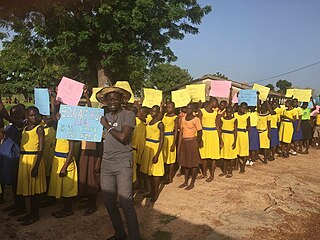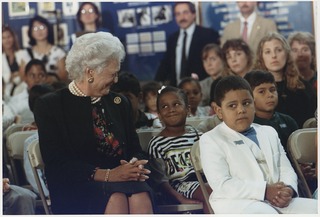
Literacy in its broadest sense describes "particular ways of thinking about and doing reading and writing" with the purpose of understanding or expressing thoughts or ideas in written form in some specific context of use. In other words, humans in literate societies have sets of practices for producing and consuming writing, and they also have beliefs about these practices. Reading, in this view, is always reading something for some purpose; writing is always writing something for someone for some particular ends. Beliefs about reading and writing and its value for society and for the individual always influence the ways literacy is taught, learned, and practiced over the lifespan.

Phonics is a method for teaching people how to read and write an alphabetic language. It is done by demonstrating the relationship between the sounds of the spoken language (phonemes), and the letters or groups of letters (graphemes) or syllables of the written language. In English, this is also known as the alphabetic principle or the alphabetic code.
Instructional scaffolding is the support given to a student by an instructor throughout the learning process. This support is specifically tailored to each student; this instructional approach allows students to experience student-centered learning, which tends to facilitate more efficient learning than teacher-centered learning. This learning process promotes a deeper level of learning than many other common teaching strategies.

Reading for special needs has become an area of interest as the understanding of reading has improved. Teaching children with special needs how to read was not historically pursued due to perspectives of a Reading Readiness model. This model assumes that a reader must learn to read in a hierarchical manner such that one skill must be mastered before learning the next skill. This approach often led to teaching sub-skills of reading in a decontextualized manner. This style of teaching made it difficult for children to master these early skills, and as a result, did not advance to more advanced literacy instruction and often continued to receive age-inappropriate instruction.

Inclusion in education refers to all students being able to access and gain equal opportunities to education and learning. It arose in the context of special education with an individualized education program or 504 plan, and is built on the notion that it is more effective for students with special needs to have the said mixed experience for them to be more successful in social interactions leading to further success in life. The philosophy behind the implementation of the inclusion model does not prioritize, but still provides for the utilization of special classrooms and special schools for the education of students with disabilities. Inclusive education models are brought into force by educational administrators with the intention of moving away from seclusion models of special education to the fullest extent practical, the idea being that it is to the social benefit of general education students and special education students alike, with the more able students serving as peer models and those less able serving as motivation for general education students to learn empathy.

Guided reading is "small-group reading instruction designed to provide differentiated teaching that supports students in developing reading proficiency". The small group model allows students to be taught in a way that is intended to be more focused on their specific needs, accelerating their progress.
Pratham is one of the largest non-governmental organisations in India. It was co-founded by Madhav Chavan and Farida Lambay. It works towards the provision of quality education to the underprivileged children in India. Established in Mumbai in 1994 to provide pre-school education to children in slums, Pratham today has interventions spread across 23 states and union territories of India and has supporting chapters in the United States, UK, Germany, Sweden, and Australia.
Shared reading is an instructional approach in which the teacher explicitly models the strategies and skills of proficient readers.
Direct Instruction (DI) is a term for the explicit teaching of a skill-set using lectures or demonstrations of the material to students. A particular subset of direct instruction, denoted by capitalization as Direct Instruction, refers to a specific example of the approach developed by Siegfried Engelmann and Wesley C. Becker. DI teaches by explicit instruction, in contrast to exploratory models such as inquiry-based learning. DI includes tutorials, participatory laboratory classes, discussion, recitation, seminars, workshops, observation, active learning, practicum, or internships. Model includes "I do" (instructor), "We do", "You do".

Reciprocal teaching is an instructional activity that takes the form of a dialogue between teachers and students regarding segments of text for the purpose of constructing the meaning of text. Reciprocal teaching is a reading technique which is thought to promote students' reading comprehension. A reciprocal approach provides students with four specific reading strategies that are actively and consciously used to support comprehension: Questioning, Clarifying, Summarizing, and Predicting. Palincsar (1986) believes the purpose of reciprocal teaching is to facilitate a group effort between teacher and students as well as among students in the task of bringing meaning to the text.
Reciprocal teaching is best represented as a dialogue between teachers and students in which participants take turns assuming the role of teacher. -Annemarie Sullivan Palincsar
Balanced literacy is a theory of teaching reading and writing that arose in the 1990s and has a variety of interpretations. For some, balanced literacy strikes a balance between whole language and phonics and puts an end to the so called reading wars. Others say balanced literacy, in practice, usually means the whole language approach to reading.

Literacy in the United States was categorized by the National Center for Education Statistics into different literacy levels, with 92% of American adults having at least "Level 1" literacy in 2019. According to the U.S. Department of Education, 54% of adults in the United States have prose literacy below the 6th-grade level.

Reading is the process of taking in the sense or meaning of letters, symbols, etc., especially by sight or touch.
Donna Alvermann is an American educator and researcher in the field of Language and Literacy Education whose work focuses on adolescent literacy in and out of school, inclusive of new media and digital literacies. Her most recent research interest involves developing historical-autobiographical methods for uncovering silences in scholarly writing that mask more than they disclose. She is the Omer Clyde and Elizabeth Parr Aderhold Professor in Education in the Mary Frances Early College of Education at the University of Georgia (UGA). She is also a UGA-appointed Distinguished Research Professor in the Department of Language and Literacy Education.
Visual literacy in education develops a student's visual literacy – their ability to comprehend, make meaning of, and communicate through visual means, usually in the form of images or multimedia.

Smart Way Reading and Spelling is a commercial brand of reading instruction methodology and materials that was developed in 2001 by Bright Sky Learning.
Peer-mediated instruction (PMI) is an approach in special education where peers of the target students are trained to provide necessary tutoring in educational, behavioral, and/or social concerns.(Chan et al., 2009). In PMI, peers may mediate by modeling appropriate behavior themselves, using prompting procedures to elicit appropriate behavior from the target students, and reinforcing appropriate behavior when it occurs. The peer tutors are chosen from the target students' classrooms, trained to mediate and closely observed during mediation.
Concept-Oriented Reading Instruction (CORI) was developed in 1993 by Dr. John T. Guthrie with a team of elementary teachers and graduate students. The project designed and implemented a framework of conceptually oriented reading instruction to improve students' amount and breadth of reading, intrinsic motivations for reading, and strategies of search and comprehension. The framework emphasized five phases of reading instruction in a content domain: observing and personalizing, searching and retrieving, comprehending and integrating, communicating to others, and interacting with peers to construct meaning. CORI instruction was contrasted to experience-based teaching and strategy instruction in terms of its support for motivational and cognitive development.
Literacy with an Attitude, written by Patrick J. Finn, attempts to redefine literacy as the term exists within the education field. In his professional life, Finn served as an Associate Professor Emeritus of the Graduate School of Education from the University of Buffalo. He also and co-chairs a committee of Urban Education through the University of Buffalo that helps provide support for the schools and school districts in Buffalo, NY. His book outlines the differences between 'domesticating' and 'liberating' education, and offers advice on how to fix the discrepancy between upper and lower class schools. Finn references studies conducted by other published authors within the field of education, including Jean Anyon and James Gee.
Newcomer education is the specialized teaching of refugees, migrants, asylees, and immigrants who have resettled in a host country, with the goal of providing the knowledge and skills necessary to integrate into their country of refuge. Education is the primary way by which newcomers can adjust to the linguistic, social, and cultural environments of their new communities. Newcomer education aims to empower newcomers with a sense of self-efficacy and social integration, as well as giving them the skills to pursue employment or higher education. Newcomer education also aims to help address trauma, culture shock, and other negative effects of forced displacement. Education for newcomers can provide long-term prospects for stability of individuals, communities, countries and global society.



